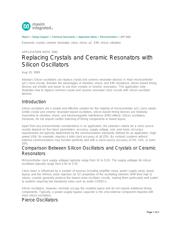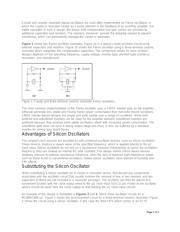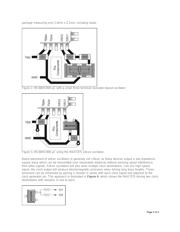下载

Maxim > Design Support > Technical Documents > Application Notes > Microcontrollers > APP 3582
Keywords: crystal, ceramic resonator, clock, micro, uC, EMI, shock, vibration
APPLICATION NOTE 3582
Replacing Crystals and Ceramic Resonators with
Silicon Oscillators
Aug 15, 2005
Abstract: Silicon oscillators can replace crystal and ceramic-resonator devices in most microcontroller
(µC) clock circuits. Besides the advantages of vibration, shock, and EMI resistance, silicon-based timing
devices are smaller and easier to use than crystals or ceramic resonators. This application note
illustrates how to replace common crystal and ceramic-resonator clock circuits with silicon-oscillator
devices.
Introduction
Silicon oscillators are a simple and effective solution for the majority of microcontroller (µC) clock needs.
Unlike crystal and ceramic resonator-based oscillators, silicon-based timing devices are relatively
insensitive to vibration, shock, and electromagnetic interference (EMI) effects. Silicon oscillators,
moreover, do not require careful matching of timing components or board layout.
Apart from any environmental considerations in an application, the selection criteria for a clock source
usually depend on four basic parameters: accuracy, supply voltage, size, and noise. Accuracy
requirements are typically determined by the communications standards defined for an application. High-
speed USB, for example, requires a total clock accuracy of ±0.25%. By contrast, systems without
external communications may function perfectly well with a clock-source accuracy of 5%, 10%, or even
20%.
Comparison Between Silicon Oscillators and Crystals or Ceramic
Resonators
Microcontroller clock supply voltages typically range from 1V to 5.5V. The supply voltages for silicon
oscillators typically range from 2.4V to 5.5V.
Clock noise is influenced by a number of sources including amplifier noise, power supply noise, board
layout, and the intrinsic noise rejection (or 'Q') properties of the oscillating element. With their high Q
values, crystals generally produce the lowest noise oscillator circuits, making them particularly well suited
to systems requiring low baseband noise such as audio CODECs.
Silicon oscillators, however, normally occupy the smallest space and do not require additional timing
components. Typically, a power-supply bypass capacitor is the only external component required with
most silicon oscillators.
Pierce Oscillators
Page 1 of 4






